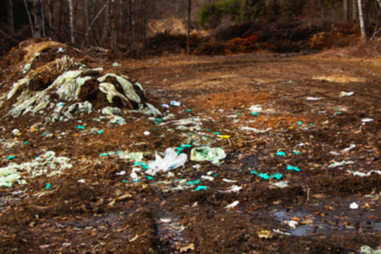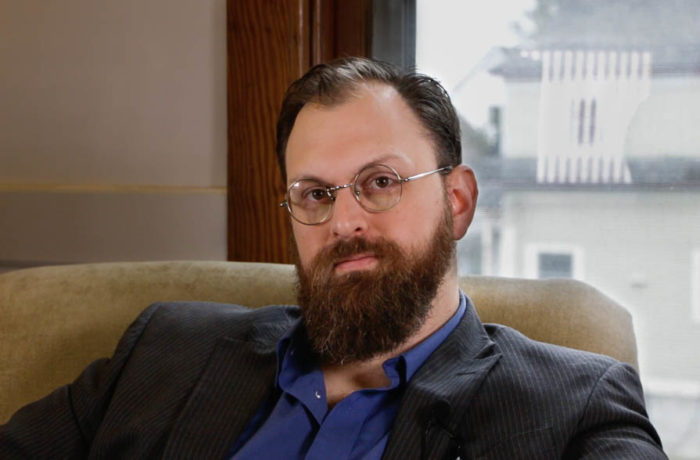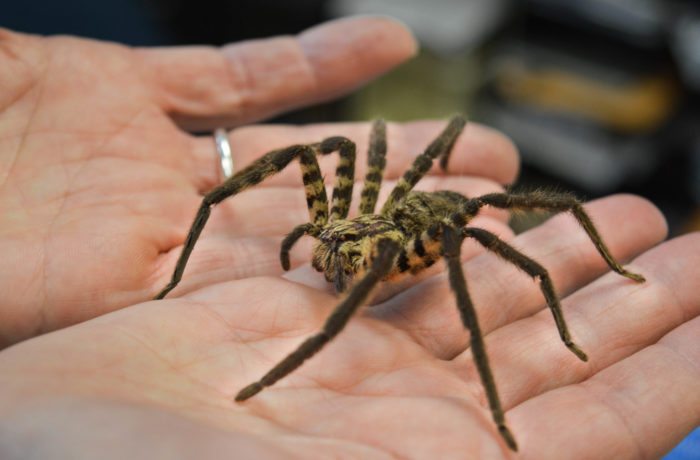
By Lance Reynolds
Osrica McLean ’18 takes a coyote skull out of a bin that holds her research collection. As she tries to separate the coyote’s jaw from the rest of the skull, other parts start to fall apart. McLean knows exactly why she couldn’t continue measuring the skull — it was too old and too fragile.
The senior biology and economics double major has spent more than 100 hours since August examining and measuring around 95 coyote skulls from around the country to wrap up a five-year research project under the supervision of Declan McCabe, chair of the biology department.
“It came kind of naturally,” McLean said with a chuckle when explaining what it first felt like to hold a coyote skull. “There was this weird hairy one they didn’t really clean well, so that was weird and kind of gross.”
The purpose of the project is to show the geographical variation across the country within coyotes. McCabe and McLean have learned through the research that New England coyote skulls are much larger than skulls from other regions in America.
There are two hypotheses for why New England coyote skulls are larger than other regions, according to McCabe. One is that the New England coyote population hybridizes with wolves meaning that they have a good chunk of wolf DNA. For example, New England coyotes have larger and more powerful jaws. The second is that when coyotes migrated into the northeast in the early 1900s, there were no wolves, so coyotes had a lot more freedom to hunt for larger prey.
Reviewers at Northeast Naturalist, a journal focusing on the biological and ecological aspects of Northeast environments and organisms, assumed that since New England coyote skulls were larger than skulls of coyotes from other regions of the country, they must have been older in age. However, McLean has proven otherwise through the study of the skull’s sutures.
“You’d expect the younger skulls would have open sutures underneath their skulls and as they grow older, they’d close up,” McLean said.
“We discovered that the animals are not actually older in the northeast – they are about the same age as the ones out west,” McCabe said.
McCabe has sent research to Northeast Naturalist in the past but it failed to result in publication, as the journal wanted a more accurate measurement length of the skulls instead of the most varied measurement length – from the front of the skull to the back.
McLean said she has measured a more accurate and reliable measurement – from the anterior of the skull on the premaxillary bone (above the incisors) to the occipital condyles at the posterior of the skull.
“Whatever I’ve learned on skulls, I’ve really learned on this project,” McCabe said. “I’m certainly learning new stuff, and Osrica is teaching me new stuff.”
McCabe bought his first coyote skull in 2012 from a student for 30 dollars and since then, he and three students, including McLean, have studied over 100 different coyote skulls from around the country, which McCabe has primarily bought off Ebay.
“The original intent was for us to have a teaching resource so students could measure the skulls,” McCabe said. “I had such a good collection that I turned it into a research project.”

Catherine Vu ’15, studied coyote skulls throughout her undergraduate days at St Michael’s and was one of two students who helped McCabe start the project during the 2011-2012 academic school year.
Vu said that the research ultimately helped pave the path to her landing her current job at Boston Children’s Hospital.
“[The] most important piece I took away is research technique, a huge impact that reflected across my academics course after course, through senior seminar, and in my current position as a clinical research assistant at Boston Children’s Hospital,” Vu said in an email.
Not only has the project helped reveal important facts about coyotes, it has also showed the importance of digital archives.
Since McCabe began accumulating skulls, he and his students have created a digital library where 120 archives are stored of the different skulls they have studied. The archives help McLean make the most accurate measurements of the skulls as possible. McCabe said that it’s the biggest digital library of coyote skulls currently on the internet.
“There are other archives, but the archives of skulls typically show you one specimen of every species they can get,” McCabe said.
“It’s important because Professor McCabe is trying to show that you can use digital archives to do accurate research,” McLean said, “and it would make it more readily available for researchers out there.”
Although the project has been conducted as a means for further understanding on coyotes and digital archives, there are many different ways the research results can be used.
“I can see this data being carried out with other aim,” Vu said. “To me, I think that’s the power of this coyote skull data set: it’s dense and wide enough to support many research foci.”
In the coming weeks, McCabe hopes the research over the past five years will result in a successful publication in Northeast Naturalist.
McLean ultimately wants to go to dental school after she graduates in May, and although the project doesn’t directly relate to dentistry, she recognizes the project’s value.
“Without it, I wouldn’t have done any research experience in college,” McLean said. “This was a really great opportunity, and with it being my last year here at St. Mike’s to be able to [have] a research opportunity was something I wanted to do.”


